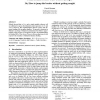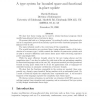1715 search results - page 4 / 343 » How Space Structures Language |
LREC
2010
2010
Inter-Annotator Agreement on a Linguistic Ontology for Spatial Language - A Case Study for GUM-Space
13 years 8 months ago
In this paper, we present a case study for measuring inter-annotator agreement on a linguistic ontology for spatial language, namely the spatial extension of the Generalized Upper...
EUROSYS
2007
ACM
13 years 11 months ago
2007
ACM
To anticipate or not to anticipate -- that is the question, regarding adaptive middleware in the area of ubiquitous computing. Anticipation can guarantee that both the adapted and...
IFIP
1992
Springer
13 years 11 months ago
1992
Springer
We provide a structured classification of properties to guide the principled design of interactive systems. This classification is motivated by an existing software quality framew...
ICFP
2007
ACM
14 years 7 months ago
2007
ACM
Filinski showed that callcc and a single mutable reference cell are sufficient to express the delimited control operators shift and reset. However, this implementation interacts p...
NJC
2000
13 years 7 months ago
2000
We show how linear typing can be used to obtain functional programs which modify heap-allocated data structures in place. We present this both as a "design pattern" for ...


